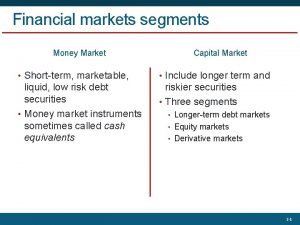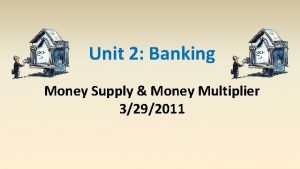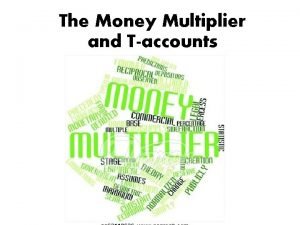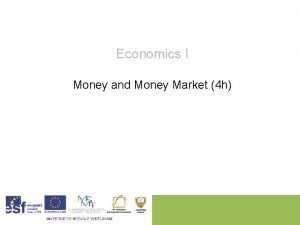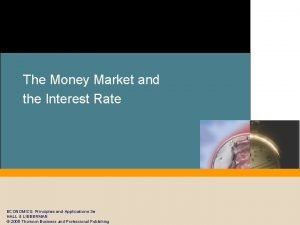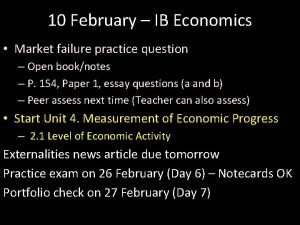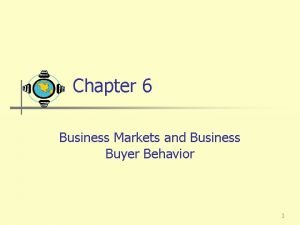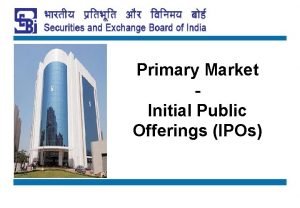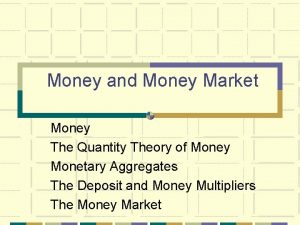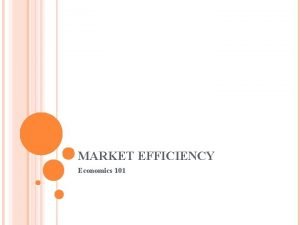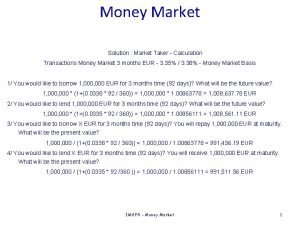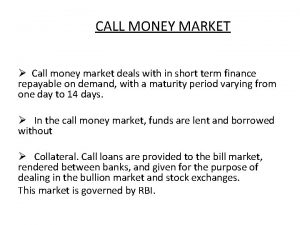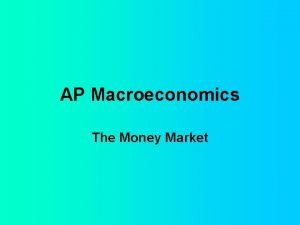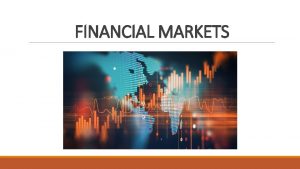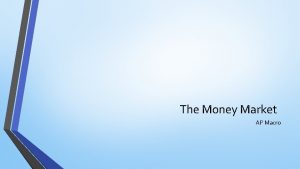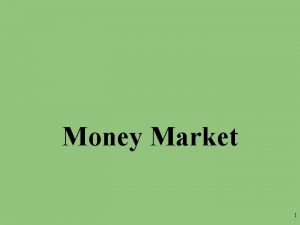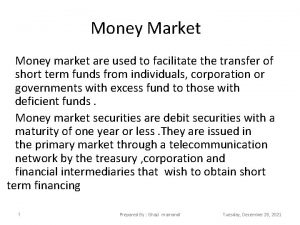Economics I Money and Money Market 4 h

















- Slides: 17

Economics I Money and Money Market (4 h)

Money and Money Market • The aim of the first lecture is to define money, their forms and functions that the money performs in the economy. Next, we will focus on the origin and evolution of money and the current components of the money supply. In the next step the objective is to define the banking system and to explain the creation of bank deposits (using simple money multiplier). This lecture will form the basis for subsequent interpretation devoted to the money market. • The goal of the second lecture is to characterize the money market, define the money supply and money demand explain the factors that influence them. Moreover, next step is to explain the equation of exchange, the quantitative theory of money and interpret what neutrality of money means.

Content • introduction – defining the goals • money - definition, origin and evolution of money, functions of money • contemporary money and monetary aggregates • banking system • creation of banking deposits - deposit multiplication • money market - money demand money supply • equation of exchange and the quantitative theory of money • conclusion – summary, homework

Money - definition, origin and evolution of money, functions of money • money: a generally accepted equivalent exchange, means of payment, the most liquid form of assets • two basic approaches to money: functional and empirical • exogeneity and endogeneity of money • origin and evolution of money (depends on the development of exchange) • three main functions of money: 1. medium of exchange 2. unit of account 3. store of value

Contemporary money and monetary aggregates • definition of current money: money is not currently covered (by gold), with forced circulation, money is accepted because they are legally prescribed currency • basic forms of current money: i. coins ii. bills iii. deposit money (accounting, fictitious, bank, giro) • monetary aggregates: According the EU methodology: M 1: currency in circulation, overnight deposits M 2: M 1 + deposits with agreed maturity up to 2 years and deposits redeemable at notice up to 3 months M 3: M 2 + repos, shares/units of money market funds, money market paper and debt securities up to 2 years • general classification: aggregate M 0, M 1, M 2, M 3 (L).

The sense of breakdown of these monetary aggregates • the resolution of monetary aggregates is not identical in all countries • a central bank wants to know the size of the money supply - money that businesses really hold and which affect the behavior of market actors and therefore the course of economic events • monetary policy can respond quickly and appropriately to adverse economic shocks - events 6

Banking system • the existence of the financial market is assumed • direct and indirect funding (there is an efficiency of utilization of resources) • the banking system in the developed market economies - usually two basic levels: • I. a central bank II. the net of commerial banks the main functions of the central bank: a. emission function b. supervision of commercial banks c. monetary policy d. bank of all commercial banks e. state bank f. management of foreign exchange reserves g. representation of the banking system and the state in the field of international monetary relations and organizations • the goal of a central bank vs. the goal of commercial banks

Creation of banking deposits - deposit multiplication • the deposit multiplication: the process of generating deposits to bank accounts • deposit multiplication means the conversion of deposits and reserves in loans and their return on deposits (deposits multiplication condition). The following is the process of converting the mortgage in expenses, which are sales of another economic entity, and these sales will appear again as bank deposits (in banks of “next stage”) • Increase in bank deposits is reduced by reserves in next stage (i. e. PMR = reserve requirements) and converges to zero • the formula: ΔD = ΔR. 1/r ΔD = incremental deposits ΔR = increment of reserves r = rate of required reserves 1/r. . . simple money multiplier • the process of making the deposit money works in the opposite direction • powerful money: reserves + currency outside the banking sector, or the monetary base, these powerful money passes through multiplication 8

Money market - money demand money supply • demand for money: it expresses the amount of money at the price (interest rate) that economic operators are willing to hold • requested amount of money may not equal the amount of money offered • theory of liquidity preference - motives of money holding: I. III. transaction motive precautionary motive speculative motive 9

Keynesian money demand function: transaction and speculative motive L = k. Yr – h. i i L L´ when L = demand for money Yr or P k = sensitivity to change in real income (Yr) h = sensitivity to changes in interest rates (i) i 1 i 2 The demand for money grows when growing real output or price level. L 1 L 2 L 10

Money supply, the monetary base, the equilibrium at the money market • money supply: the amount of money that the economy has available, = currency in circulation and demand deposits (M 1) • monetary base, powerful money (MB) reserves + currency outside the banking sector; monetary base (MB) undergoing multiplication and depending on the money multiplier (m) the money supply (SM) is created: SM = MB. m • money multiplier “m” is not constant and predictable • the money multiplier is influenced by other effects (behavior of the central bank, commercial banks and depositors) • equilibrium at the money market is the result of an intersection of the money supply and money demand SM = DM or M/P = L t 11

Equilibrium at money market SM i. N = nominal interest rate (the average) M = amount of money i 1 SM = money supply (controlled by a central bank) E i 2 DM = demand for money DM i 3 M 1 M 2 M 3 M 12

Equation of exchange and the quantitative theory of money • P. Y=M. V P = Price level Y = real GDP M = nominal quantity of money in circulation V = velocity of monetary unit • the predecessor of the quantitative theory of money: David Hume (17111776) • the author of the classical quantitative theory of money (the so-called transaction variant): Irving Fisher (am. Economist, 1867 -1947); began with a simple analysis that every transaction has both a buyer and also the seller • the value of all sales in the economy equals the value of all purchases: (AS = AD) 13

The assumptions and conclusions of the quantity theory of money • the quantitative theory of money: if the velocity of money is given by the practice of the payment and payment technology in a society – it is a stable variable, money supply is given, it is checked by the central bank, and the volume of all transactions (sales) is constant, and the economy is on the level of potential product: then increase the amount of money supply in the economy will cause the rise in price level in the economy • reformulation of the quantity theory of money (by conservative economics - Monetarism, an important conclusion of the Monetarism: money can affect real macroeconomic variables in the short term only) 14

Literature • FRANK, R. H. , BERNANKE, B. S. Principles of Macroeconomics. 3 rd Edition. Mc. Graw. Hill/Irwin: NY, 2007. ISBN 978 -0 -07 -319397 -7. 561 p. • MANKIW, G. N. Principles of Macroeconomics. 4 th ed. USA: Thomson South. Western, 2007. 583 p. ISBN 978 -0 -324 -23695 -8. • Mc. CONNELL, C. R. , BRUE, S. L. Economics: Principles, Problems, and Policies. 17 th ed. NY: Mc. Graw/Irwin. 716 p. ISBN 978 -0 -07 -312663 -0. • SAMUELSON, P. A. , NORDHAUS, W. D. Economics. 15 th ed. Mc. Graw-Hill, 1995.

Homework Exercise “Money and banking deposit creation” • Assume Mr. Thrifty had sold treasury bills to the central bank in the amount of 500, - monetary units and after it he deposited this amount in one of the commercial banks. The level of required reserves is 7. 5 %. Calculate the money generated by increases in the first 5 stages of deposit multiplication and figure out the overall monetary increase in the banking system - after all stages. • Find out the actual level of minimum reserves in your country and calculate simple deposit multiplier. For the Czech Republic, visit the website of the Czech National Bank (http: //www. cnb. cz).

Homework Exercise “Money Market” • In the economy output (GDP) was to increase and the households received additional income. Draw a change at the money market and discuss the new equilibrium at the market - determining the equilibrium interest rate and the amount of money supply in the economy. • Assume that the economy shows these statistical figures: real GDP = 379, 000 mil. , average price level (P) = 2. 45 and money supply (M) = 362, 000 mil. Calculate the velocity of monetary unit.
 Capital market and money market
Capital market and money market Money market and its functions
Money market and its functions Money money money team
Money money money team International segmentation
International segmentation Market leader follower challenger nicher
Market leader follower challenger nicher Maastricht university economics and business economics
Maastricht university economics and business economics Mathematical economics vs non mathematical economics
Mathematical economics vs non mathematical economics Goldman sachs
Goldman sachs Money multiplier economics
Money multiplier economics Money multiplier formula
Money multiplier formula Quantity theory of money economics
Quantity theory of money economics Chapter 30 money growth and inflation
Chapter 30 money growth and inflation Money market supply and demand
Money market supply and demand Dineshbakshi economics
Dineshbakshi economics Primary target market and secondary target market
Primary target market and secondary target market A model of business buyer behavior
A model of business buyer behavior Market identification
Market identification Difference between primary market and secondary market
Difference between primary market and secondary market
